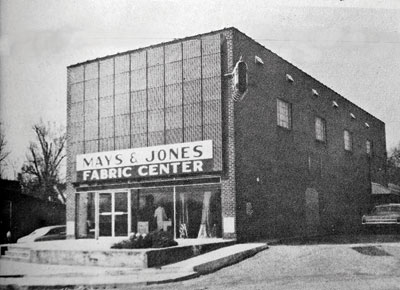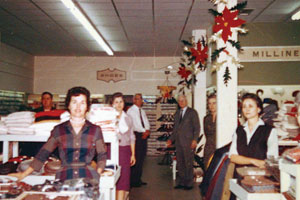
 When Mays & Jones was the place to shop
When Mays & Jones was the place to shop
Story by Jerry C. Smith
Photos by Wallace
Bromberg Jr.
Submitted photos
Its motto might well have been MOUNTAIN BROOK GOODS AT PELL CITY PRICES. The owners of Mays & Jones Department Store spared no effort to bring the finest merchandise to their establishment.
From 1923 until its closing in the mid 1970s, Mays & Jones was the premier clothing and linens emporium in Pell City, and according to many who worked and traded there, the store’s business personality mirrored the quality of its goods.
Originally built in 1905 as Pell City Bank & Trust by the town’s founder, Sumter Cogswell, the building was remodeled in 1923 as Mays & Jones Department Store. Its construction was of brick made at Ragland Brick Company. Although solely owned by local retailer Blair Jones, he added his wife’s maiden name to the store’s façade to show that it was indeed a family business.
Pell City resident Florence Compton, now 89 years of age but looking 60, relates that she loved every minute of her 31 years as their bookkeeper. Her career began in 1943, just after she graduated from Pell City High School. “It was a wonderful place to work,” she says. “Mr. Jones had a heart of gold and would bend over backward to see that every customer was able to find exactly what they wanted.”
Mays & Jones was not without competition. Downtown Pell City hosted other stores that carried similar inventory, such as Mitnick’s, Cohen’s and Roberson’s. Lorene Smith, who started her long career in Ladies’ and Childrens’ Shoes in 1946, often accompanied Mr. Jones on buying expeditions to ensure the store carried only the best medium-range goods. Jones also had buyers who went to dealerships in New York and elsewhere. He wanted his store to be the destination of choice for local folks who wanted uptown quality at an affordable price.
Garland Davis of Mineral Springs Road tells that he and twin brother, Harland, often picked blackberries at 50 cents per gallon to pay for their school clothes and would never think of buying them anywhere other than Mays & Jones.
Former store manager Mack Taylor, who served from 1968 until 1971, advanced their trade even further by arranging for advertising fliers, originally printed for Bob Cornett’s local newspaper, St. Clair Observer, to also be inserted in the Birmingham News. Soon customers were coming in from all over. Taylor says there were often 40-50 people waiting for the doors to open on sale days, many of them from Birmingham, Ragland and Ashville.
Most store employees had long tenure and displayed a strong loyalty to Mr. Jones. Florence and co-worker Lorene recall working with Jones’ wife Dixie Ann; Virginia Nelson; Linda & Etha May Haynes; Carolyn Robertson; June Tillery; twin sisters Clara & Mary Mays; Warner Hammett; Tommy Davis; Mildred Hardwick; Thurman Henninger; Nettie & Mary Cornett; Dixie Ann’s brother “Buddy” Mays; Peggy Pruett; Louella Starnes; Helen Hutton; Florence’s sister Clara May Compton; and Thurman Burnham. They also recall Tom and Essie Lovell, who worked together. He was in floor sales, and she handled clothing alterations.
Thurman “Red” Henninger created eye-catching window displays. He later set up his own Red’s Menswear store on Martin Street, next to the old Jack’s location. “Bunny” Beavers was janitor and also managed the stock room, which stayed very busy due to their ample stocks and liberal layaway plan.
Customers first
The store’s normal complement was eight to 10 workers, mostly in floor sales. As with many firms in those days, there were few of the benefits people take for granted today. Workers were paid a flat monthly salary. They worked six full days a week, except Wednesdays, when everything in town closed at noon. All hands were expected to be there promptly at opening time, formally dressed and ready to work. Everyone stayed until the last customer had been served.
This policy sometimes became irksome as last-minute customers dropped in, particularly on Fridays, shopped at great leisure, then left without buying anything. Employees were not allowed to clean up or shut down any department as long as a customer was in the store.
Many part-time extras, usually teenagers, were hired during big sales and the holiday season. Their layaway system saw heavy use during these times. Large numbers of paychecks were cashed on Fridays, some from the ordnance works at Bynum, but mostly from Avondale Mills. And you did not have to be a regular customer. Mr. Jones felt that, if he cashed enough checks, you would soon shop there because of their thoughtful service.
 Among Mays & Jones’ product offerings were shoes for the whole family; women’s coats, dresses, stockings, lingerie and sportswear; men’s suits and haberdashery items; some house linens; and other soft goods.
Among Mays & Jones’ product offerings were shoes for the whole family; women’s coats, dresses, stockings, lingerie and sportswear; men’s suits and haberdashery items; some house linens; and other soft goods.
They also ordered custom uniforms for local banks and other firms with staff who served the public.
At one time the store sold toys and other home items, but its inventory eventually centered around clothing and personal items. Brands included Jarman, Sewell, Connie and Red Goose shoes, and Arrow and Van Heusen shirts.
Levi jeans were a best seller. Made from local Avondale Mills denim, these were not pre-shrunk. Many fashion-conscious buyers would put them on wet, then let them shrink-dry to conform to their body shape.
The shoe department sported an X-Ray machine, common in those days before we became aware of the dangers of radiation. Most often used on growing children, these devices displayed a live image of the bones of both feet inside a shadow image of the shoes. Youngsters gleefully wiggled their toes while Mom and the sales clerk studied a green screen inside the darkened cabinet to determine toe-room for growth. Thankfully, these well-intentioned hazards went away in the middle 1950s.
Lorene adds, “You wouldn’t believe how many people tried on shoes on the wrong feet. And one lady said she needed a larger size because her feet “expired real bad.”
Gerald Ensley related a story about buying shoes during World War II. In those days, leather was a strategic material needed for the war effort, so purchases were made using ration stamps, with only one pair a year allowed. Gerald’s mother had given him a stamp, and told him to buy some school shoes for the coming term on their charge account.
Gerald was told to buy brogans, a simple, inexpensive, rugged shoe whose un-cured war-time leather often wrinkled and discolored when wet. Upon reaching the store, however, Gerald first did a little window shopping, and noticed a fine-looking pair of patent leather shoes on a mannequin. Mom or not, he decided that’s what he wanted.
Mr. Jones told Gerald that he knew his mother had not sent him there to buy those, as such shoes often came apart from the rigors of being on a young boy’s feet. But Gerald insisted, and left the store sporting snazzy, shiny patent leather shoes.
Unfortunately, it had been raining that day, and the way back was sodden with mud holes and puddles. By the time Gerald got home, his fine new shoes had loose, flapping soles and had long since lost their glassy sheen.
A helping hand
Mays & Jones had a long-standing reputation for helping those in need. Florence relates that they had more than a thousand credit customers. Taylor tells of an unemployed truck driver who came there looking for work clothes but had no money. He was given clothes on credit, and as soon as the man got his first paycheck, returned with a payment. Further, he brought Taylor 5 pounds of shrimp from his new job of transporting seafood from Florida, and thence used the store for all his family’s clothing needs.
Taylor says that Mr. Jones customarily spoke to everyone, even people walking by on the sidewalk. Lorene adds, “He didn’t spend his day sitting back there in his office; he was out front greeting customers.” He was known for commiserating with townsfolk in needy circumstances, offering kindly advice as well as goods. A dedicated community man who never refused to make a charitable donation, Jones served as an officer in the Chamber of Commerce and Lions Club and was a devout Methodist.
The building’s second floor was reserved for rentals to business clients, among them the Pell City DHR office. Current building trustee, attorney Ted Van Dall, says that during the building’s hundred-year-plus history there has always been at least one lawyer upstairs. Attorney/judge Edwin Holladay was once a tenant. Dr. R.A. Martin’s brother, Claude, had a dental office there.
Another one-time tenant, Bill Hereford, was a former attorney, judge and mayor of Pell City. He says the front windows were helpful to lawyers because they could see who was walking with whom from the courthouse to Rexall for lunch and who visited other law firms on the square.
Hereford purchased the Jones’ family home on 3rd Avenue North in 1987 and still lives there today. It’s a magnificent old dwelling, faithfully preserved except the old steam radiators and attic fan have been upgraded to central heat and air.
He tells that the Jones family had the first television set in Pell City in the early 1950s and that Jones delighted in inviting neighborhood kids in to watch the Saturday shows. Jones’ daughter, Dixie Ann Newman, was a former legal client of Hereford’s.
After Jones’ passing in 1968, the business was owned for a few years by Dixie Ann’s family, the Newmans, before the main store was shut down in the early 1970s. Some remaining inventory was moved to another short-lived location in the present Ben M. Jacobs Masonic Lodge building. Established by Mack Taylor, this new store was called Mays & Jones Home Goods.
In 1975, the original building suffered major damage in a tornado that struck downtown. Various other firms have since occupied its repaired premises, which now hosts Farmer’s Insurance Company. The old bank safe and vault still exist, far back in a rear corner. It’s always left open and unused because the combination is long-forgotten. It’s only been robbed once, by someone who chiseled a hole through the second floor, then blasted the safe with dynamite. The yegg was never caught.
Both Florence and Lorene speak highly of their days at Mays & Jones, naming it an ideal place to work and shop. Most anyone over age 60 in Pell City will attest to its quality, fairness, and genuine concern for customers that brought them back year after year.
Fore more images of Mays & Jones Department Store, read the full digital or print edition of the August & September 2014 edition of Discover The Essence of St. Clair Magazine.















